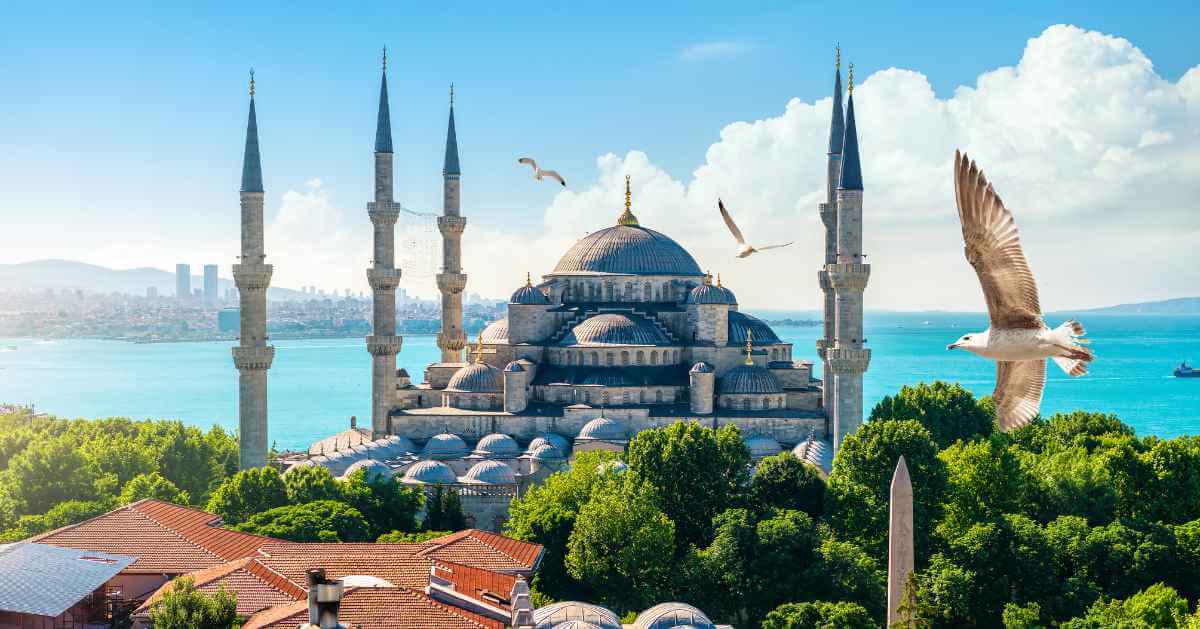The Blue Mosque: A Magnificent Masterpiece of Islamic Architecture and Culture

The Blue Mosque, also known as Sultan Ahmed Mosque, is a stunning example of Islamic architecture that you will get to see in your Turkey Tours by TravelVerse. Completed in 1616, the mosque is named after Sultan Ahmed I, who commissioned its construction. It is one of the most iconic landmarks of Istanbul and attracts millions of visitors every year. This article will explore the historical significance, architectural features, decorative elements, and cultural role of The Blue Mosque, as well as provide tips for visiting and interesting facts about this magnificent masterpiece.
Historical significance of The Blue Mosque
The Blue Mosque was built during the Ottoman Empire, which was one of the world’s most powerful empires during its reign from the 14th to the early 20th century. The mosque was constructed as a symbol of the Ottoman Empire’s power and wealth, and to compete with the nearby Hagia Sophia, which was then a Byzantine cathedral. The construction of The Blue Mosque was also intended to boost the Ottoman economy by providing employment opportunities for thousands of workers.
The mosque was designed by the famous Ottoman architect, Sedefkar Mehmed Agha. It took seven years to complete and was inaugurated in 1617. The mosque’s unique feature is the six minarets, which was a bold move as the Great Mosque of Mecca has only five. It is said that the Sultan Ahmed I wanted the mosque to be the most impressive in the world, hence the decision to add the extra minaret.
Architectural features of The Blue Mosque
The Blue Mosque is a masterpiece of Islamic architecture and features a perfect blend of Ottoman, Byzantine, and Islamic styles. The mosque covers an area of 4,800 square meters and has a capacity of 10,000 worshippers. The main dome of the mosque is 23.5 meters in diameter and is supported by four massive pillars and four half domes. The interior of the mosque is decorated with intricate designs, calligraphy, and beautiful stained glass windows.
The mosque’s façade is made of blue tiles, which gives the mosque its nickname. The blue tiles were imported from the city of Iznik, which was famous for its ceramics during the Ottoman Empire. The mosque also has 260 windows, which provide natural light and ventilation. The courtyard of the mosque is also impressive and features a fountain for ablutions, or ritual washing before prayer.
Decorative elements of The Blue Mosque
The Blue Mosque is not only renowned for its architectural features but also for its decorative elements. The interior of the mosque is adorned with more than 20,000 blue tiles, which were hand-painted with intricate floral and geometric designs. The tiles were made in Iznik and are of the highest quality.
The mosque’s calligraphy is also impressive, with verses from the Quran and other Islamic texts written in beautiful Arabic scripts. The calligraphy was done by the famous calligrapher, Seyyid Kasim Gubari. The mosque’s stained glass windows are also a sight to behold, with their vibrant colors and intricate designs.
The role of The Blue Mosque in Islamic culture
The Blue Mosque is more than just a place of worship; it has played a significant role in Islamic culture throughout history. The mosque has been a center of learning, with scholars and students gathering to study Islamic theology and law. The mosque has also served as a place for important ceremonies and events, such as the coronation of Ottoman sultans.
Today, The Blue Mosque continues to be an important place of worship for Muslims around the world. It is also a popular tourist attraction, providing visitors with an opportunity to learn about Islamic culture and history.
Visiting The Blue Mosque – tips and guidelines
Visiting The Blue Mosque is a must-do activity when in Istanbul. However, there are certain rules and guidelines that visitors should follow to show respect for the mosque and its worshippers. Visitors must remove their shoes before entering the mosque and dress modestly, covering their arms and legs. Women are also required to cover their hair with a scarf.
Visitors should also be mindful of prayer times and avoid entering the mosque during prayer times, which are five times a day. Visitors should also avoid taking photos during prayer times and should not touch any religious artifacts or disturb worshippers.
Interesting facts about The Blue Mosque
- The mosque has six minarets, which caused controversy when it was built as it was believed that only the Great Mosque of Mecca should have six minarets.
- The mosque features more than 20,000 hand-painted blue tiles.
- The mosque’s courtyard has a capacity of 30,000 people.
- The mosque has a unique feature where the call to prayer is recited from the balcony of the minaret instead of inside the mosque.
Similar mosques around the world
The Blue Mosque is not the only mosque that showcases Islamic architecture and culture. There are several other mosques around the world that are worth visiting, such as:
- The Great Mosque of Mecca, Saudi Arabia
- The Sheikh Zayed Grand Mosque, Abu Dhabi
- The Al-Aqsa Mosque, Jerusalem
- The Hassan II Mosque, Morocco
- The Badshahi Mosque, Pakistan
Preservation and restoration efforts of The Blue Mosque
The Blue Mosque has undergone several restoration efforts over the years to ensure its preservation for future generations. The most recent restoration was completed in 2020, which included the cleaning and restoration of the mosque’s interior and exterior.
The restoration efforts have been successful in maintaining the mosque’s structural integrity and preserving its decorative elements. The mosque’s tiles, calligraphy, and stained glass windows have been carefully restored to their original beauty.
